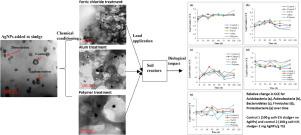Water Research ( IF 12.8 ) Pub Date : 2021-10-14 , DOI: 10.1016/j.watres.2021.117757 Zainab Abdulsada 1 , Richard Kibbee 2 , Dina Schwertfeger 3 , Juliska Princz 3 , Maria DeRosa 4 , Banu Örmeci 2

|
The growing use of silver nanoparticles (AgNPs) in personal care products and clothing has increased their concentrations in wastewater and subsequently in sludge raising concerns about their fate and toxicity during wastewater treatment and after land application of sludge. This research investigated the fate and removal of AgNPs during chemical conditioning of anaerobically digested sludge and their impact on soil bacteria and health after land application. Ferric chloride (FeCl3), alum (Al2 (SO4)3 • (14-18) H2O), and synthetic (polyacrylamide) polymer were used for sludge conditioning. All conditioners effectively removed AgNPs from the liquid phase and concentrated them in sludge solids. Concentration analyses showed that out of 53.0 mg/L of silver in the sludge, only 0.1 to ˂0.003 mg/L of silver remained in the sludge supernatant after conditioning and 12 to 20% of this value were particulates. Morphological analyses also showed that AgNPs went through physical, chemical, and morphological changes in sludge that were not observed in nanopure water and the resulting floc structures and the incorporation of nanoparticles were different for each conditioner. The impact of conditioned AgNPs on the biological activities of soil was evaluated by investigating its impact on the presence of five important phyla (Acidobacteria, Actinobacteria, Bacteroidetes, Firmicutes and Proteobacteria). The results showed that AgNPs at a concentration of 20 mg AgNPs/g soil had a minimal impact on the presence and diversity of the assessed phyla. Also, using different chemicals for sludge conditioning resulted in different growth behavior of studied phyla. This study provides new insight into how the presence of AgNPs and different chemicals used for sludge conditioning might impact the soil biological activities and hence plant growth. The study also provides a solid basis for further research in the risk assessment of nanoparticle toxicity in biosolids amended soils.
中文翻译:

模拟土地施用后污泥调理过程中银纳米颗粒的去向和去除及其对土壤健康的影响
在个人护理产品和服装中越来越多地使用银纳米粒子 (AgNPs) 增加了它们在废水和污泥中的浓度,引发了人们对它们在废水处理过程中和污泥土地应用后的归宿和毒性的担忧。本研究调查了厌氧消化污泥化学调理过程中 AgNPs 的去向和去除及其对土壤细菌和土地施用后健康的影响。氯化铁 (FeCl 3 )、明矾 (Al 2 (SO 4 ) 3 • (14-18) H 2O) 和合成(聚丙烯酰胺)聚合物用于污泥调理。所有调节剂都有效地从液相中去除了 AgNPs,并将它们浓缩到污泥固体中。浓度分析表明,在污泥中 53.0 mg/L 的银中,只有 0.1 到 ˂0.003 mg/L 的银保留在调节后的污泥上清液中,并且该值的 12% 到 20% 是颗粒物。形态学分析还表明,AgNPs 在污泥中经历了在纳米纯水中未观察到的物理、化学和形态变化,并且由此产生的絮体结构和纳米颗粒的掺入对于每种调节剂都是不同的。通过研究其对五种重要门(酸杆菌、放线菌、拟杆菌、厚壁菌门和变形菌门)。结果表明,浓度为 20 mg AgNPs/g 土壤的 AgNPs 对评估门的存在和多样性的影响最小。此外,使用不同的化学品进行污泥调理会导致所研究门的不同生长行为。这项研究提供了关于 AgNPs 和用于污泥调理的不同化学品的存在如何影响土壤生物活动以及植物生长的新见解。该研究还为进一步研究生物固体改良土壤中纳米颗粒毒性的风险评估提供了坚实的基础。使用不同的化学品进行污泥调理导致所研究门的不同生长行为。这项研究提供了关于 AgNPs 和用于污泥调理的不同化学品的存在如何影响土壤生物活动以及植物生长的新见解。该研究还为进一步研究生物固体改良土壤中纳米颗粒毒性的风险评估提供了坚实的基础。使用不同的化学品进行污泥调理导致所研究门的不同生长行为。这项研究提供了新的见解,了解 AgNPs 和用于污泥调理的不同化学品的存在可能如何影响土壤生物活动,从而影响植物生长。该研究还为进一步研究生物固体改良土壤中纳米颗粒毒性的风险评估提供了坚实的基础。


























 京公网安备 11010802027423号
京公网安备 11010802027423号